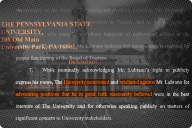You have /5 articles left.
Sign up for a free account or log in.
In his recent op-ed, “For-Profits’ War on Philanthropy,” Johann Neem misses the point. Unfortunately, his deep philosophical opposition to for-profit colleges and universities gets in the way of an honest discussion.
While he’s absolutely right that public universities have long played a vital role in society, he fails to see that it’s ultimately the students, more than the universities or their legal structure, that matter. In today’s world with a very diverse population, very diverse workplace-skill demands, and a very diverse student body, we should celebrate the diversity of our postsecondary delivery system. I’d suggest that each element of higher education today -- public, private nonprofits and private for-profits -- plays a different, yet important, role.
As a professor himself, Neem rightly takes pride in the importance of not-for-profit colleges in society and their role in advancing the “public good.” What Dr. Neem should be focusing on, however, is the needs of American students.
Private sector colleges and universities offer unique opportunities for millions of men and women, particularly young professionals, military veterans and working parents. For our schools, the first-time, full-time student right out of high school is the rare exception rather than the norm. These institutions have enabled millions of Americans to obtain specialized degrees in a wide variety of fields. If that’s not advancing the public good, I don’t know what is.
For many of our students, who are seeking higher education while maintaining a household and full employment, a career-focused and specialized education from a private sector college or university is simply the most viable option.
Neem claims, without basis, that for-profit universities don’t have a vested interest in their students. One veteran, while re-registering for new classes in one of our schools, told me, “I could have attended a lot of other colleges and universities in this area. But this school, with its focused academic delivery of one course at a time, and the flexible scheduling, was the kind of education I need at this time in my life.”
What most confuses me about Neem’s article is his suggestion that for-profit colleges undermine the traditional role of philanthropy. Having served the past six years as the president and chief executive officer of the Council on Foundations, I happen to know something about the philanthropic sector.
First, let’s understand that philanthropy -- unlike charity -- is meant to be a long-term strategic investment in positive social change.
When I first arrived at the council, philanthropies were engaged in “competitive grant-making.” They would consider multiple grant requests and select the most innovative proposals.
But as impact became an important part of their work, most grant making institutions moved to strategic philanthropic investments, where a multiyear investment was made to create positive and real social change. Since the Great Recession, philanthropy has recognized the limit of public, private and philanthropic resources. In response, the sector has moved to public-private-philanthropic partnerships. The sector’s work with the Obama administration in areas such as “Race to the Top” and the Social Innovation Fund are prime examples of this change.
Today, private sector colleges and universities represent the classic example of a public-private-philanthropic partnership in higher education. Foundations do incredible work related to research and best practices in workforce investment strategies. The government funds programs like the Workforce Investment Act and Title IV to support students seeking to obtain workplace skills. Our schools -- and yes, their owners -- invest in the design and delivery of education programming. At a time when state and federal budgets are limiting support and access in traditional institutions of higher education, we should all celebrate the role private-sector colleges and universities provide to keeping our nation competitive and to equipping our students with the skills demanded in today’s workplace.
Today, public-private-philanthropic partnerships demand that we all work together to achieve change with limits on resources. We both combine and leverage resources. Lifelong learning and workforce investment is a classic example of this exemplified by the National Fund for Workforce Solutions. This same partnership is critical to our efforts to produce the skilled workers needed for the next decade. Look at the pioneering work of the Lumina, Gates, Mott and other foundations in this area -- especially most of our community foundations across the nation.
There’s no reason why both private and public education can’t play a vital role in America’s long-term recovery. The world is changing. So must education.








